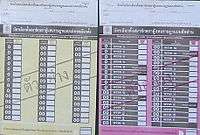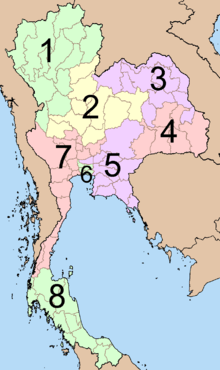Elections in Thailand
 |
| This article is part of a series on the politics and government of Thailand |
|
|
|
Constitution |
|
|
|
Elections in Thailand (Thai: การเลือกตั้งในประเทศไทย) refers to the democratic process in which some parts of the Government of Thailand is selected. These include the House of Representatives of Thailand, the Senate of Thailand (combined to create National Assembly of Thailand), local Administrations, Governorship of Bangkok and national referendums. Thailand has so far had 25 general elections since 1933; the last election was in 2014. Voting in elections in Thailand is compulsory. All elections in Thailand are regulated by the Election Commission of Thailand.
Suffrage

Elections are held under universal suffrage in accordance with the 2007 Constitution; however, certain restrictions apply:
- The voter must be a national of Thailand; if not by birth, then by being a citizen for 5 years.
- They must be over 18 years old the year before the year the election is held.
- The voter must have also registered ninety days before the election at his constituency.
- Those barred from voting in House elections are: members of the sangha or clergy, those suspended from the privilege (for various reasons), detainees under legal or court orders, and people of unsound mind or of mental infirmity.
Elections
House of Representatives
The House of Representatives consists of 480 members, of which 400 are directly elected through the first past the post system in which each member represents one "constituency". The other 80 is elected through "proportional representation"; in fact, it is a form of parallel voting or a mixed member majoritarian system, in which the voter first casts a vote for his or her constituency MP and then a second vote for party preference. At the end of election the 80 seats are allotted in accordance with these second votes, through party lists given to the election commission by the political parties before election day. Party list MPs are selected from eight lists based on eight "electoral areas":

- Area 1 : 11 provinces with a population of 7,615,610 - Chiang Mai, Chiang Rai, Mae Hong Son, Phayao, Nan, Lampang, Lamphun, Phrae, Sukhothai, Tak, and Kamphaeng Phet
- Area 2 : 9 provinces with a population of 7,897,563 - Nakhon Sawan, Uthai Thani, Phetchabun, Phichit, Phitsanulok, Chaiyaphum, Khon Kaen, Lop Buri, and Uttaradit
- Area 3 : 10 provinces with a population of 7,959,163 - Nong Khai, Udon Thani, Loei, Nakhon Phanom, Sakon Nakhon, Nong Bua Lamphu, Kalasin, Mukdahan, Maha Sarakham, and Amnat Charoen
- Area 4 : 6 provinces with a population of 7,992,434 - Roi Et, Yasothon, Ubon Ratchathani, Si Sa Ket, Surin, and Buri Ram
- Area 5 : 10 provinces with a population of 7,818,710 - Nakhon Ratchasima, Nakhon Nayok, Prachin Buri, Sa Kaeo, Chachoengsao, Chonburi, Rayong, Chanthaburi, Trat, and Pathum Thani
- Area 6 : 3 provinces with a population of 7,802,639 - Bangkok, Nonthaburi, and Samut Prakan
- Area 7 : 15 provinces with a population of 7,800,965 - Kanchanaburi, Suphan Buri, Nakhon Pathom, Ratchaburi, Phetchaburi, Prachuap Khiri Khan, Chumphon, Ranong, Chai Nat, Sing Buri, Ang Thong, Phra Nakhon Si Ayutthaya, Saraburi, Samut Sakhon, and Samut Songkhram
- Area 8 : 12 provinces with a population of 7,941,622 - Surat Thani, Phang Nga, Nakhon Si Thammarat, Krabi, Phuket, Trang, Phatthalung, Satun, Songkhla, Pattani, Narathiwat, and Yala
Special elections can be called if the candidate fail to pass the commission's standards (Known as yellow-cards) or if a vacancy occurs. The commission also have the authority to annul or ban candidates based on their standards (Red-cards). The term for the House is 4 years not fixed. The last election for the House occurred in 2007.
The electoral system was changed on 11 February 2011, with an increase to 500 seats in the House, of which 375 will come from constituencies and 125 from party lists.[1] Furthermore, the division of the party list into area lists was abolished.
Further reading: Thai general election, 2011
Senate
The Senate is composed of 150 members. Of these, 76 are directly elected, while 74 members are appointed. Of the elected members, 75 come from the Provinces of Thailand, and one from the Bangkok Metropolitan Area. The Senate is a non-partisan chamber and therefore candidates cannot be a member of a political party. The election is based on the first past the post system. Terms are fixed at six years. The last election for the Senate occurred in 2008.
Further reading: Thai Senate election, 2008
_02.jpg)
Local Administration
There are three different levels of municipalities (Thai: เทศบาล), which all elect their own municipal council and mayor. The municipalities are split into constituencies, which each elect six councillors. The number of constituencies depends on the municipal level.
- thesaban nakhon (city): 4 constituencies, 24 councillors.
- thesaban mueang (town): 3 constituencies, 18 councillors.
- thesaban tambon (subdistrict municipality): 2 constituencies, 12 councillors.
The Tambon Administrative Organizations, a local government similar to the municipalities, also has an elected council and mayor. Every administrative village within the TAO sends two councillors to the council, only if there are less than three villages the number of councillors per villages is increased to reach the minimum size of six councillors. Pattaya as a special administrative area has a council with 24 seats and an elected mayor, same as a city.
Additionally, every province has a province-wide local government named Provincial Administrative Organization with an elected council and chairman. The size of the council depends of the population of the province.
For all the local governments, the electoral term is four years. If a councillor positions becomes vacant, a by-election is held in the corresponding constituency, if a mayor position becomes vacant, a new election for a four-year term is held. Thus elections for mayor and council aren't necessarily on the same date.
City of Bangkok
Councils
Bangkok is divided into 50 local district councils, one for every district. The size of these councils differ between 7 and 8. Additionally, there are 61 seats in the Bangkok Metropolitan Council, (BMC). The election follow a 4 years cycle. Most recent local election was in 2010.
Gubernatorial
The Governor of Bangkok is the only elected Governor in the country. The Governor holds a four-year renewable term. The election does not coincide with that of the district councils or the BMC. The most recent election for Governor of Bangkok was in 2013.
Referendums
There has only been two constitutional referendums, in 2007 and 2016.
Further reading: Thai constitutional referendum, 2007 and Thai constitutional referendum, 2016
Issues
There have been many issues especially in recent years concerning elections in Thailand. Accusations of vote buying and blackmail have been most cited. Most accusations leveled concern vote buying, particularly in rural areas where representatives of political parties or district captains are sent out offering up to 2,000 Baht for a vote. Others concern cheating and ballot tampering.
Other issues concern the powers of the Election Commission, an unelected and unaccountable body of five, which has absolute authority to cancel elections at will. It is also the sole arbiter and interpreter of Thai election laws. It has been incredibly active in the last two general elections in annulling and disqualifying candidates.
Voter turnout during elections is not much of a problem in Thailand as voting is compulsory and is one of the responsibilities described in the Constitution a citizen must exercise. Turnout is however much higher during general elections (85% in 2007) than they are for Senate (56% in 2008) or local elections (54% for Bangkok Governor in 2008).
See also
References
- ↑ "Approved charter amendments pave way for Thai new election - People's Daily Online". English.people.com.cn. Retrieved 2011-02-13.
External links
- Adam Carr's Election Archive
- Thailand Electoral Commission
- Thailand at the Consortium for Elections and Political Process Strengthening (CEPPS)